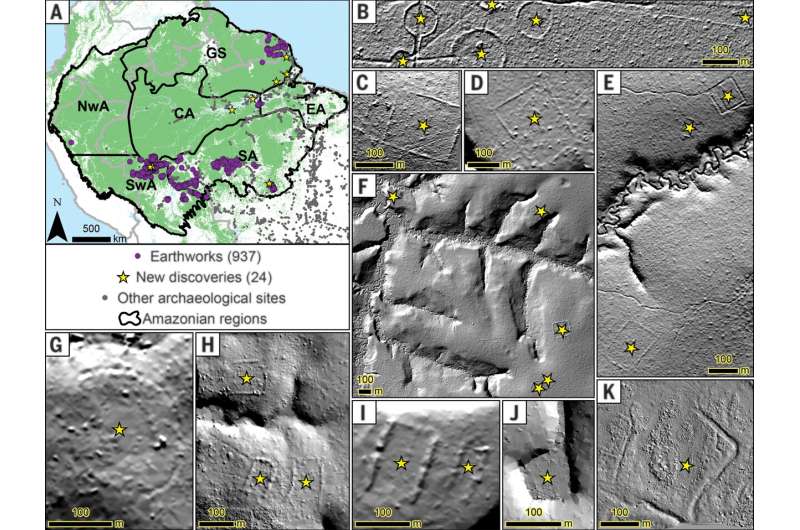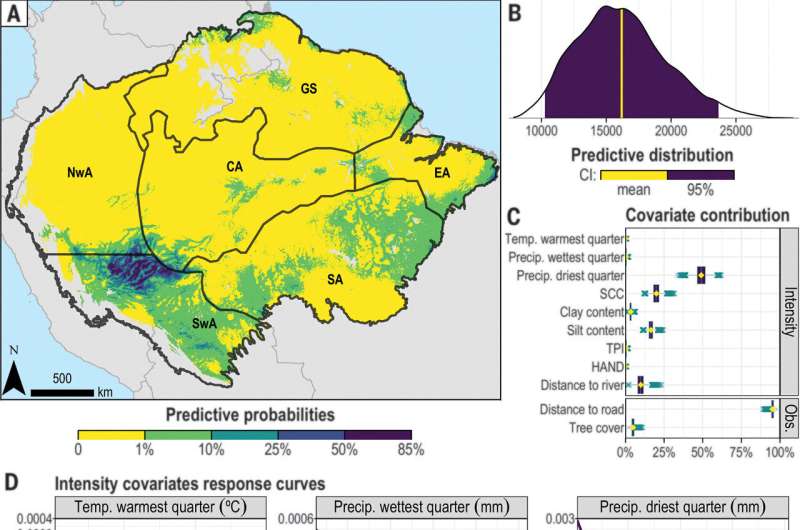This article has been reviewed according to Science X's editorial process and policies. Editors have highlighted the following attributes while ensuring the content's credibility:
fact-checked
peer-reviewed publication
trusted source
proofread
Amazon rain forest hides thousands of records of ancient Indigenous communities under its canopy, says new study

The world's most diverse forest, the Amazon, may also host more than 10,000 records of pre-Columbian earthworks (constructed prior to the arrival of Europeans), according to a new study. The new study combines cutting-edge remote sensing technology with archaeological data and advanced statistical modeling to estimate how many earthworks may still be hidden beneath the canopy of the Amazon rainforest and in which locations these structures are most likely to be found.
The paper
is published in the journal Science. The work was conducted by a team of 230 researchers from 156 institutions located in 24 countries across four continents, led by Brazilian researchers Vinicius Peripato, a doctoral student in Remote Sensing at Brazilian National Institute for Space Research (INPE), and Luiz Aragão. "Our study suggests that the Amazon rainforest may not be as pristine as many believe, as when we seek a better understanding of the extent of pre-Columbian human occupation throughout it, we are surprised by a significant number of sites still unknown to the science community," says Peripato. The team of scientists made this discovery after identifying 24 new archaeological sites through advanced remote mapping technology, using a laser mounted on an aircraft, known as LiDAR (Light Detection and Ranging). This sensor allows for the reconstruction of surface elements into a highly detailed 3D model. Peripato explains, "From the 3D models of the surface, it is possible to digitally remove all vegetation and initiate a precise and detailed investigation of the terrain beneath the
Using all earthworks found so far (961), the team quantified how many structures have yet to be unraveled and demonstrated that dozens of tree species are linked to these ancient occupations dating back 1,500 to 500 years ago. These structures are known as "earthworks" and predate the arrival of Europeans on the continent.
They are also typically associated with other types of landscape modifications, confirming the presence of Indigenous occupations in various regions of the Amazon (such as Amazonian dark earth and the presence of domesticated species, among other pieces of evidence).

"We predict that 90% of the Amazon forest has a very low chance of having earthworks," so this type of modification on Amazonian forests may have taken place mostly in 10% of its area," said Hans ter Steege, of Naturalis Biodiversity Center and Utrecht University.
Carolina Levis from the Federal University of Santa Catarina adds, "Some time ago, ecologists viewed the Amazon as the vast untouched forest, but now, combining other types of pre-Columbian remains, we can see how many areas that currently sustain dense forest have already been subjected to extensive engineering works and the cultivation and domestication of plants by pre-Columbian societies. These people mastered sophisticated techniques for land and plant management, which in some cases, are still present in the knowledge and practices of present-day communities that can inspire new ways to coexist with the forest without the need for its destruction."
All quantitative results mentioned above, including the information provided by the title of the paper, were obtained after applying the methodology recently developed by Guido Moreira, in his doctoral thesis in Statistics of at Universidade Federal do Rio de Janeiro, and Dani Gamerman. The Bayesian approach to Statistics is used to propose an exact regression analysis for the observed occurrences of pre-Columbian earthworks. Exactness is achieved by the use of a data augmentation mechanism that includes the still unobserved earthworks and their observability pattern.
So far, these earthworks have been commonly discovered through Google Earth images. However, due to the vastness of the Amazon rainforest and the challenges of studying remote areas, this study puts forth testable predictions about lesser-known locations in the Amazon, where new fieldwork is likely to uncover archaeological sites of monumental dimensions, still well-preserved within the forest.
Luiz Aragão, one of the leaders in the research and head of the Earth Observation and Geoinformatics Division at INPE, emphasizes, "This research represents a significant technological and scientific advancement. The study advances knowledge in three major areas, including archaeology itself through novel discoveries, environmental sciences by demonstrating the level of human interference in the region, which may have implications for its current functioning and how we model its future, and finally, in the field of applied computing, which enabled the analysis of the millions of points present in the LIDAR data and the statistical modeling of the distribution of the studied features."
This groundbreaking study also has political implications for the current debate on the Indigenous land demarcation timeline in Brazil. "In times of discussions regarding regulatory frameworks for property and Indigenous land rights, this research provides numerous pieces of evidence of the ancestral occupation of the Amazon rainforest by Indigenous peoples, their ways of life, and the relationship they established with the forest," the authors state. "The protection of their territories, languages, cultures, and heritage should be understood as ancient, as they are, and not tied to a date, which is so recent."
More information: Over 10,000 Pre-Columbian earthworks are still hidden throughout Amazonia, Science (2023). DOI: 10.1126/science.ade2541. www.science.org/doi/10.1126/science.ade2541
Journal information: Science
Provided by Max Planck Society





















